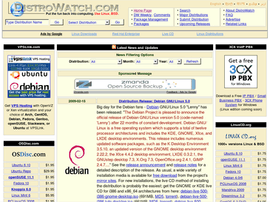DistroWatch
|
| |
 | |
Type of site | News website |
|---|---|
| Available in | English, French, Spanish, Portuguese, German, Dutch, Russian, Swedish, Hindi, Tamil, Japanese, Persian, Turkish, Hebrew, Vietnamese, Danish, Arabic |
| Owner | Ladislav Bodnar |
| Revenue | Advertisement |
| Website |
www |
| Alexa rank |
|
| Commercial | Yes |
| Registration | No |
| Launched | 31 May 2001 |
DistroWatch is a website which provides news, popularity rankings, and other general information about various Linux distributions as well as other free software/open source Unix-like operating systems such as OpenSolaris, MINIX and BSD. It now contains information on several hundred distributions.[2]
History
The website was launched on 31 May 2001 and is maintained by Ladislav Bodnar.[3]
Initially, Bodnar also wrote the Distrowatch Weekly (DWW). In November 2008, Bodnar decided to step down from the post of editor for DWW. Bodnar said he would still continue to maintain the site[4] while the DWW would be written by Chris Smart.[5]As of 9 August 2015, DistroWatch has donated a total of $44,175 USD to various open source software projects since the launch of the Donations Program in March 2004.[6]
Features
The site maintains extensive comparison charts detailing differences between the package sets and software revisions of different distributions. It also provides some general characteristics of distributions such as the price and the supported processor architectures.[notes 1] There is also a Distrowatch weekly (often abbreviated DWW) that comes out on Monday "as a publication summarising the happenings in the distribution world on a weekly basis".[4] Distrowatch has a monthly donations program, a joint initiative between DistroWatch and two online shops selling low-cost CDs and DVDs with Linux, BSD and other open source software.
Inappropriateness of the hit counters as a measure of OS usage
Distrowatch itself affirms that its page rankings are "a light-hearted way of measuring the popularity of Linux distributions and other free operating systems among the visitors of this website. They correlate neither to usage nor to quality, and should not be used to measure the market share of distributions. They simply show the number of times a distribution page on DistroWatch.com was accessed each day, nothing more."[7][8][9][10]
PCWorld has written that "the page-hit counts on DistroWatch give some indication of which distributions are drawing the most interest at the moment, of course, but such measures can't be assumed to gauge who's actually using what or which are preferred overall".[11]
Notes
- ↑ e.g. see the Red Hat Enterprise Linux page on the web site https://distrowatch.com/table.php?distribution=redhat
References
- ↑ "Distrowatch.com Site Info". Alexa Internet. Retrieved 2018-06-14.
- ↑ "DistroWatch.com: Put the fun back into computing. Use Linux, BSD". DistroWatch. Retrieved 8 July 2012.
- ↑ "DistroWatch.com: Put the fun back into computing. Use Linux, BSD". DistroWatch. Retrieved 8 July 2012.
- 1 2 "DistroWatch.com: Put the fun back into computing. Use Linux, BSD". DistroWatch. Retrieved 8 July 2012.
- ↑ "DistroWatch.com: Put the fun back into computing. Use Linux, BSD". DistroWatch. Retrieved 8 July 2012.
- ↑ "DistroWatch Weekly, Issue 620, 27 July 2015". DistroWatch. Retrieved 9 August 2015.
- ↑ "How Mighty Mint became one of the most popular Linux distros". TechRadar. Retrieved 22 May 2013.
- ↑ Terry Relph-Knight (2012-02-10). "A tale of two distros: Ubuntu and Linux Mint". ZDNet. Retrieved 2015-11-23.
- ↑ Jake Edge (2011-12-07). "Distribution "popularity"". LWN.net. Retrieved 2015-11-23.
- ↑ "Groklaw - Some Facts about openSUSE and Distrowatch Figures - A Correction". Groklaw. 11 January 2007. Retrieved 17 June 2012.
- ↑ Noyes, Katherine (25 April 2012). "Which Linux Distro Is Fairest of Them All? Ubuntu, Survey Says". PCWorld. Retrieved 17 June 2012.